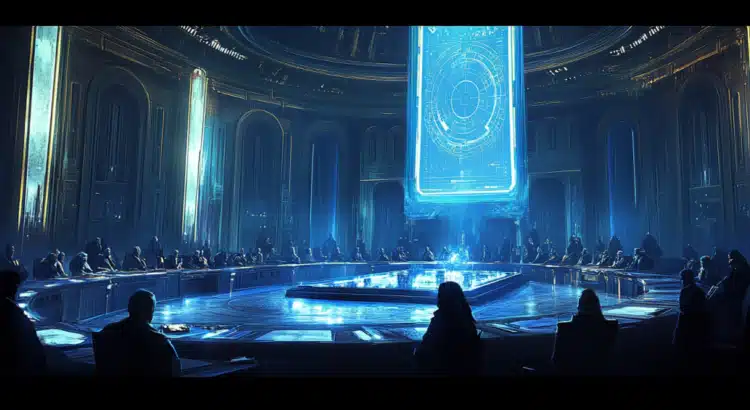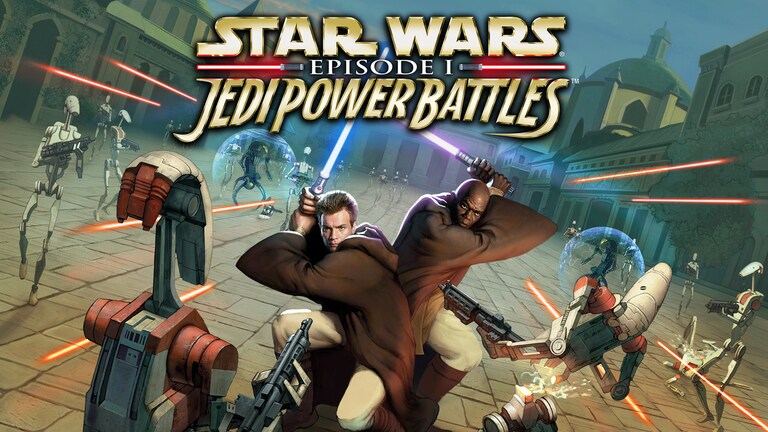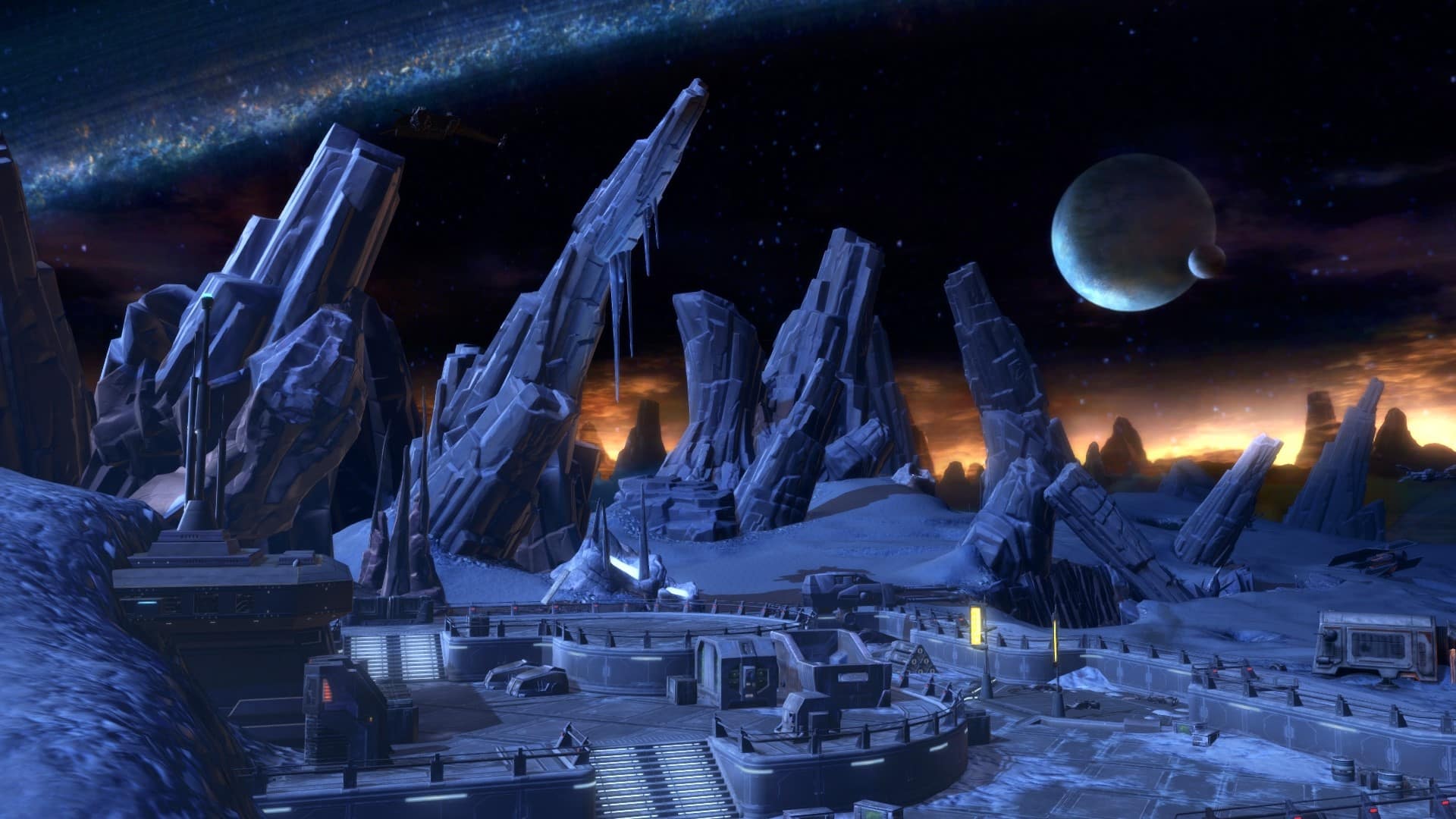Ah, the grand galaxy of Star Wars, where epic space battles rage, the Force flows, and lightsabers ignite in dazzling displays of Jedi skill. But for all the flash and dazzle, do you know what really makes the galaxy tick? Nope, it’s not the Force, or even the Jedi Council’s questionable decision-making. It’s economics, baby! Trade disputes, taxes, and economic policies have a bigger role in galactic politics than even Jar Jar Binks (shocking, I know).
To understand why a movie series set “a long time ago in a galaxy far, far away” cares so much about trade disputes, we have to dig deep into how economic power defines political power. So, buckle up, hyperspace travelers, as we embark on a journey exploring how trade, blockades, and cold, hard credits make the wheels of galactic politics turn.
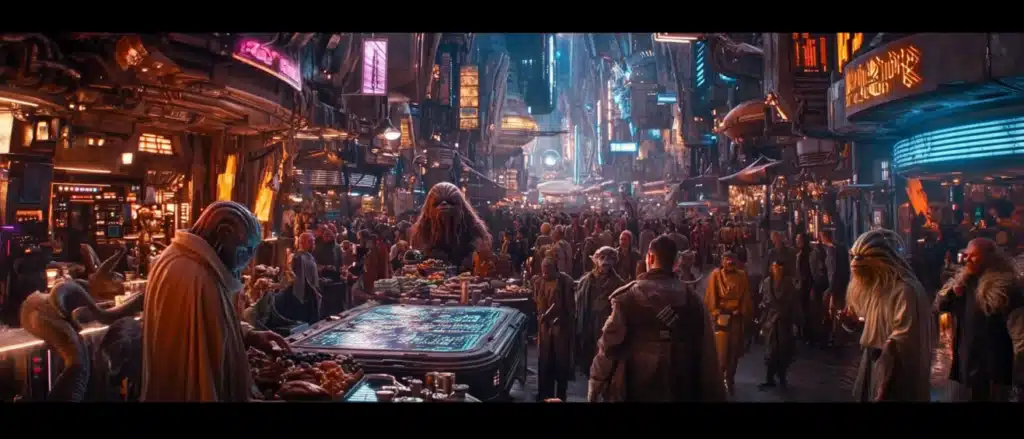
A Galaxy Shaped by Credits: Economic Foundations in Star Wars
Let’s be real for a second—what makes the galaxy of Star Wars spin? Sure, there’s the Force, an endless supply of dramatic father-son confrontations, and an alarming amount of cloaked menacing laughter echoing down dark corridors. But beneath all that excitement lies the beating heart of the galactic economy. It may not have the pizzazz of a Death Star trench run, but trust me, the economy is what really makes this galaxy tick. So, let’s break down the nuts and bolts of how credits, trade routes, and economic might shape the Star Wars universe.
Hyperlanes: The Galaxy’s Arteries
In a galaxy where distances between planets are measured in light-years, you can’t exactly rely on your trusty Tatooine land speeder to deliver goods. That’s where hyperlanes come in—the galaxy’s equivalent of interstellar highways. Hyperlanes allow ships to zip through hyperspace at mind-bending speeds, connecting core worlds, mid-rim planets, and even outer rim territories in a web of commerce and interaction.
Major hyperlanes like the Corellian Run and the Hydian Way serve as the primary arteries of galactic trade. Control over these routes translates into immense economic power, which in turn makes planets or organizations strategically important. The Galactic Republic, for example, maintained its dominance partly by keeping these routes open and regulated (although “regulation” often felt like a leisurely Senate debate punctuated by endless droid testimonies). Planets located at key hyperlane junctions, like Corellia, became thriving hubs of trade and manufacturing, while remote systems often languished in economic obscurity.
Major Economic Players: Titans of the Galactic Marketplace
When discussing Star Wars economics, you can’t avoid mentioning the big players who wield economic clout like a Sith wields a red lightsaber. Among these players, the Trade Federation looms large—a conglomerate of merchants and manufacturers who built a veritable empire (not to be confused with the Empire, though there’s plenty of overlap in shady dealings).
The Trade Federation initially sold itself as a coalition promoting free trade across the galaxy. Sounds harmless, right? But “free trade” quickly transformed into “trade domination.” By controlling supply chains, setting tariffs, and deploying legions of battle droids (because who doesn’t need an army to go with their board meetings?), the Federation became more than just a trade entity—it became a political force capable of intimidating entire star systems. Think of them as a combination of the most aggressive corporate monopolies and the most cunning political operators rolled into one.
They weren’t alone. The galaxy also housed other powerful economic organizations, such as the Corporate Alliance, the Techno Union, and the Banking Clan. These entities operated as a combination of ruthless megacorporations and powerful lobbyist groups, making deals behind closed Senate doors and dictating terms that affected millions. As a result, the line between economic and political power blurred. If you controlled trade, you controlled everything—from taxation and tariffs to political influence and military support.
Credits Make the Galaxy Go ‘Round
Credits—the universal currency of the galaxy—may seem like mere pocket change for smugglers looking to upgrade their ships or pay off their debt to Jabba the Hutt. But credits have a far more insidious role in shaping galactic politics. Economies thrive or collapse depending on the flow of credits. Wealthy planets like Coruscant, with its towering skyscrapers and glittering spires, became economic and political hubs because of their massive influx of credits. Meanwhile, struggling planets like Ryloth were often left to fend for themselves, at the mercy of slavers and criminals.
In a galaxy ruled by credits, the gap between the wealthy and the impoverished planets became stark. Many worlds turned to the galactic black market to survive, smuggling essential goods, weapons, or even spices. Smugglers, pirates, and criminal syndicates like the Hutt Cartel thrived as shadow economies grew beneath the surface of legitimate commerce. And while crime was rampant, it was often tolerated—or even exploited—by those in power. This delicate economic balance underscored a cold, hard truth: galactic politics and economics were deeply intertwined, with credits often dictating who held power and who groaned under its weight.
Hypercapitalism Meets Hyperpolitics
The Republic’s economic policies were a double-edged lightsaber (metaphorically, that is—though someone in the galaxy probably tried to market one). On the one hand, they sought to encourage trade and economic cooperation across the stars. On the other hand, the policies were easily manipulated by unscrupulous organizations like the Trade Federation. Trade agreements, tariffs, and resource allocations frequently became battlegrounds for political maneuvering. If you thought a heated Senate debate was intense, imagine throwing in the threat of an embargo or a blockade.
The Galactic Republic, for all its lofty ideals of democracy and fairness, found itself at the mercy of lobbying groups and economic giants who knew how to work the system. Policies that should have encouraged economic prosperity for all became a way for a select few to gain immense power. We’ve all heard the phrase “follow the money,” and in the Star Wars universe, that path often leads to the highest echelons of galactic politics—or the darkest corners of Sith manipulation.
A Complicated Web of Dependency
Trade in the galaxy isn’t just about shiny baubles and crates of coaxium (though who doesn’t love a good energy source?). It’s about survival. Planets depend on trade for vital resources, technology, and even food. This dependency creates a fragile network where any disruption—be it a blockade, an embargo, or a tariff—can lead to widespread suffering and instability. Just as the Trade Federation’s blockade of Naboo exposed the Republic’s weaknesses, countless other disputes showed how economic power could destabilize entire star systems.
For example, when the Separatists sought to break away from the Republic, economic factors were front and center. The war wasn’t just about politics or ideology—it was about economic control. The Separatist Alliance, led by Count Dooku and supported by the Trade Federation and other industrial giants, used their financial power and control over key resources to challenge the Republic. The resulting conflict, which would become the infamous Clone Wars, was as much an economic struggle as it was a battle between Jedi and Sith.
From Riches to Ruin: Economic Strife Across the Galaxy
Not every planet got to play with the big boys of trade, though. For many outer rim planets and smaller systems, economic strife was a way of life. Without representation in the Senate or control over trade routes, they were often exploited, taxed into submission, or simply ignored. This economic disparity laid the groundwork for unrest and rebellion, as seen in movements like the Rebellion against the Empire.
The Empire, for its part, used economic oppression as a means of control. By restricting trade, seizing resources, and enforcing brutal sanctions, they ensured loyalty—or at least compliance—through sheer economic might. Those who resisted, like the Rebel Alliance, often relied on smuggling, underground markets, and guerilla tactics to keep their fight alive. In the end, economics became not just a means of survival but a battleground for freedom.
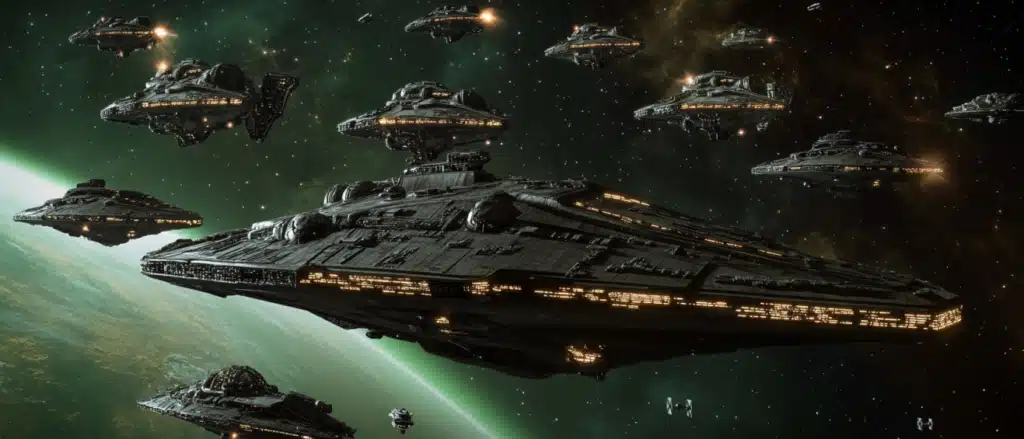
Trade Gone Wrong: Episode I and the Trade Federation’s Blockade
In the annals of Star Wars history, there are countless epic battles, thrilling duels, and heroic moments that define the franchise. Yet, who would have thought a dispute over taxes and trade routes could kick off a galactic saga? In Episode I: The Phantom Menace, the story doesn’t begin with a grandiose battle or an ominous prophecy but with the rather mundane (though deeply consequential) matter of a trade blockade. While it may not be as glamorous as podracing or as chilling as Darth Maul’s double-bladed lightsaber, the blockade of Naboo set the stage for a chain of events that would ultimately lead to the rise of the Empire and the fall of the Jedi Order. Let’s take a closer look at how one trade dispute went horribly wrong, destabilizing the galaxy far, far away.
Why Blockade Naboo? The Catalyst of Economic Discontent
It all started with taxes. No one likes taxes—especially not powerful interstellar corporations like the Trade Federation, who are used to making obscene amounts of credits with as little oversight as possible. For years, the Galactic Republic had allowed free trade zones to flourish without imposing taxes, ensuring that hyperlanes and trade routes were accessible and lucrative. However, when the Republic, perhaps strapped for cash to fund yet another Senate subcommittee on Gungan linguistics (I can only imagine), decided to impose new taxes on these routes, it set off a firestorm.
The Trade Federation, led by Viceroy Nute Gunray, wasn’t about to let this slide. In protest, they imposed a blockade on Naboo, a small yet strategically significant planet with a pacifist queen and a penchant for extravagant fashion. Why Naboo? The Federation’s choice wasn’t random; it was a calculated move to make a point and force the Republic to reconsider its taxation policies. Naboo’s location near vital trade routes and its lack of military strength made it an ideal target for the Trade Federation’s economic “tantrum.”
The Mechanics of a Blockade: More Than Just Ships in Space
To the untrained eye, the blockade might have seemed like a bunch of droid-controlled starships loitering around Naboo, blocking shipments of space bananas and Nabooian wine. But the reality was much more severe. Blockading a planet in the Star Wars galaxy is a highly sophisticated and often ruthless maneuver. By positioning their fleet in orbit around Naboo, the Trade Federation effectively cut off all trade and supplies to and from the planet. Food shortages, economic turmoil, and desperation spread across the Nabooan populace. In essence, it was economic warfare on a massive scale.
The blockade was not just about making a statement; it was about asserting dominance and coercing the Republic through economic pressure. Every day the blockade continued, the people of Naboo suffered, giving Viceroy Gunray leverage to negotiate—or, more accurately, to bully the Republic into reversing its tax policy. While Naboo’s elegant cities and lush landscapes may have given off a serene appearance, the reality was anything but peaceful.
Queen Amidala’s Desperate Plea: Bureaucracy at Its Worst
Faced with mounting hardship, Queen Padmé Amidala, Naboo’s young and determined monarch, did what any leader would do: she went to the Galactic Senate for help. Surely, the governing body of the Republic would intervene to save a defenseless planet under siege, right? Wrong. Welcome to the galactic equivalent of endless red tape and gridlock. The Senate, notorious for its slow-moving bureaucracy and petty squabbles, became paralyzed by infighting and political maneuvering.
Here’s where things get even more infuriating. Despite clear evidence of the Trade Federation’s aggressive actions, the Senate couldn’t agree on a course of action. Representatives loyal to powerful corporate interests (gee, I wonder who!) used procedural delays and called for “fact-finding committees” to investigate the situation. If you think your local government office’s response times are slow, imagine a space-age bureaucracy filled with thousands of species, each with its own interests, and a few Sith Lords sprinkled in for good measure. Queen Amidala’s pleas fell on deaf ears, highlighting the Republic’s ineffectiveness and setting the stage for more drastic measures.
Behind the Scenes: Palpatine’s Master Plan
Of course, there was more to the blockade than meets the eye. As with many things in the Star Wars saga, there was a Sith Lord lurking behind the scenes, manipulating the situation to his advantage. Enter Sheev Palpatine, a seemingly mild-mannered senator from Naboo who just so happened to be Darth Sidious, a master of the dark side with a penchant for grandiose schemes.
Palpatine orchestrated the crisis from the shadows, guiding the Trade Federation’s actions like a puppet master pulling strings. Why? Because chaos breeds opportunity, and Palpatine thrived on chaos. By pushing the Trade Federation into blockading Naboo, he engineered a crisis that would elevate his political career and weaken the Republic’s stability. It’s no accident that Queen Amidala’s frustration with the Senate led her to call for a vote of no confidence in Chancellor Valorum, paving the way for Palpatine to rise to power. The whole blockade was less about taxes and more about a Sith power grab. Talk about playing the long game.
Battle Droids: The Federation’s Go-To Negotiation Tactic
You might be wondering why a trade organization needed a battle-hardened army of droids. The Trade Federation wasn’t content with simply sitting in orbit; they also deployed battle droids to occupy Naboo and enforce their will on the ground. The droids, as charmingly inept as they could be (thanks to programming budgets, probably), symbolized the lengths to which the Federation would go to maintain control and intimidate the Republic.
While Naboo’s Royal Guard and a couple of Jedi knights did their best to resist, the Trade Federation’s military presence made it clear: this wasn’t a negotiation. It was a hostile takeover with corporate interests backed by firepower. The Federation’s use of droid armies in their blockade is a stark reminder that when trade disputes escalate in the Star Wars galaxy, things go from “let’s talk” to “bring out the blasters” real fast.
Economic Pressure Meets Jedi Intervention
In a twist that only Star Wars can deliver, the Jedi Order became involved when Chancellor Valorum, desperate to broker a peaceful solution, secretly dispatched Jedi Master Qui-Gon Jinn and his young Padawan Obi-Wan Kenobi. From the Federation’s perspective, sending Jedi to “negotiate” was like sending a couple of battle tanks to resolve a parking dispute—it didn’t exactly inspire confidence in a peaceful resolution.
When talks predictably went south (probably because the Federation’s idea of “negotiating” involved lots of droids and blasters), the Jedi quickly shifted into “rescue-the-planet” mode. Their intervention would eventually lead to freeing Queen Amidala and her entourage, as well as the formation of an unlikely alliance with Gungan leader Boss Nass. Together, they hatched a plan to overthrow the Trade Federation’s control of Naboo, showing that even in a galaxy shaped by credits, courage and resilience still had their place.
The Aftermath: Political Fallout and Galactic Consequences
The Naboo crisis didn’t just end with the defeat of the Trade Federation’s droid army and a victory parade. Its repercussions rippled throughout the galaxy, shaking the foundations of the Republic. The blockade exposed the Senate’s inability to respond effectively to crises, highlighting just how deeply corporate interests had infiltrated galactic politics. It also gave Palpatine the political leverage he needed to rise to the position of Supreme Chancellor, setting him on his path to becoming Emperor.
For the Trade Federation, the events on Naboo marked a turning point. They would continue to play a pivotal role in the growing separatist movement, ultimately aligning with Count Dooku and the Separatist Alliance. Their willingness to engage in armed conflict and use economic pressure to achieve their goals became a blueprint for future conflicts, laying the groundwork for the Clone Wars.
The blockade of Naboo was more than just an opening act for The Phantom Menace. It was a harbinger of the galaxy’s descent into war and tyranny—a testament to how economic disputes can spiral out of control when mixed with ambition, corruption, and political stagnation. It’s a lesson that even in a galaxy full of Jedi, Sith, and droids, sometimes the greatest conflicts start with something as mundane—and as powerful—as a tax dispute.
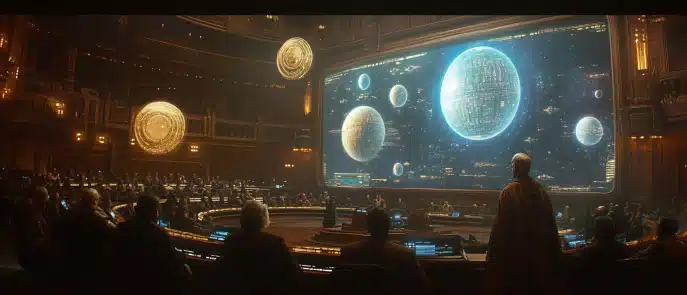
The Economics of Control: How Trade Influences Galactic Politics
In the galaxy of Star Wars, power doesn’t just come from the Force, big guns, or even armies of clones and droids. Often, the true power lies in something far less flashy, but equally potent: economic control. Trade, in all its intergalactic complexity, is not merely a means to move goods—it’s a lever for power, influence, and sometimes, straight-up galactic domination. From the rise of corporate conglomerates like the Trade Federation to the grand machinations of Emperor Palpatine, the use of economic influence shapes political decisions and defines the balance of power across the galaxy.
Trade as a Political Tool: Who Controls the Routes, Controls the Power
Control over trade routes is the Star Wars equivalent of controlling the spice flow in Dune or owning the railroads in Monopoly—it’s a huge deal. In the galaxy, major hyperlanes like the Corellian Run and the Perlemian Trade Route form the lifelines for commerce and communication. Whoever holds sway over these routes has the ability to make or break entire planets by controlling the flow of goods, essential resources, and economic access.
The Trade Federation, with its massive fleets and near-monopolistic control over shipping, knew this well. They transformed trade into a weapon, using their dominance over hyperlanes to coerce planets, block commerce, and bend political bodies like the Galactic Senate to their will. This was no simple business enterprise—it was a play for galactic influence. By leveraging their economic stranglehold on essential goods, they could negotiate from a position of power, ensuring their interests (and tax exemptions) were protected.
Consider Naboo: by imposing a blockade, the Trade Federation wasn’t just protesting taxes—they were making a statement about their authority. In a galaxy where countless planets rely on trade for survival, cutting off supply routes is akin to cutting off the air supply. It’s ruthless, effective, and politically destabilizing. Control of trade routes allows for immense influence over the very survival of star systems, making it a key factor in galactic politics.
Economic Alliances and Political Cartels: Beyond the Trade Federation
While the Trade Federation is often front-and-center in discussions about Star Wars economics, they’re just one cog in a much larger machine of economic manipulation. Other players like the Techno Union, the Banking Clan, and the Corporate Alliance wielded similar economic clout. Each of these groups had different specializations—be it technology production, financial services, or manufacturing—but they shared one thing in common: they knew how to use their economic power for political leverage.
The Banking Clan, for example, controlled the flow of credits throughout the galaxy. Need a loan to fund your starfighter fleet? The Banking Clan probably has you covered, but at a steep interest rate that just might bankrupt your planet. Through economic loans and debt manipulation, they exerted influence over planetary governments and even the Galactic Senate. They were essentially space-bankers with galactic reach, and their influence often dictated which factions had the resources to wage war—or make peace.
These economic cartels didn’t operate in a vacuum; they often worked together, creating alliances to further their own interests. The Separatist movement, led by Count Dooku, was fueled in large part by these organizations, who saw an opportunity to wrest power from the corrupt Republic. The formation of the Confederacy of Independent Systems (CIS) wasn’t just a political rebellion—it was an economically driven secession backed by some of the wealthiest and most powerful corporations in the galaxy.
Money Talks, But Palpatine Shouts
When it comes to using trade as a tool of control, no one played the game better than Sheev Palpatine, a.k.a. Darth Sidious. As the galaxy’s most cunning political operator, Palpatine understood that controlling commerce was just as important—if not more so—than wielding lightsabers or commanding armies. He used trade disputes and economic crises to stoke fear, create divisions, and ultimately consolidate power.
During the Naboo blockade, Palpatine expertly manipulated the Trade Federation’s grievances to his advantage. By inflaming tensions and fostering conflict, he positioned himself as a solution to the Republic’s political paralysis, paving the way for his rise to Supreme Chancellor. Once in power, Palpatine continued to exploit economic leverage, turning the galaxy’s corporate entities into pawns of his grand Sith agenda. Under his rule, economic organizations became key pillars of the Separatist movement, ensuring that the Clone Wars would be both politically and economically devastating.
Palpatine’s brilliance lay in his ability to orchestrate both sides of the conflict. As Darth Sidious, he guided the Separatist leaders, encouraging them to use their economic might to destabilize the Republic. As Chancellor, he claimed to be the Republic’s savior, justifying increased militarization and emergency powers—all while secretly profiting from the economic devastation. Essentially, Palpatine turned trade and economics into a galactic chessboard, where every credit and tariff served a sinister purpose.
Economic Warfare: Blockades, Sanctions, and Trade Wars
While traditional warfare in Star Wars involves blasters, starfighters, and perhaps the occasional rancor, economic warfare is equally devastating. The blockade of Naboo was just one example of how trade could be weaponized. Throughout the galaxy’s history, economic sanctions, embargoes, and trade wars have been used to force compliance, weaken enemies, and consolidate power.
For example, during the Clone Wars, the Separatist Alliance frequently used economic blockades and embargoes to bring planets to their knees. Star systems that opposed the Separatists often found themselves cut off from vital supplies or facing crippling economic hardship. In response, the Republic sometimes resorted to its own forms of economic pressure, further entrenching divisions and prolonging the conflict. While lightsaber battles and clone trooper skirmishes dominated the holo-news, the real battle for control often took place in the shadows of economic policy and trade manipulation.
The Cost of Loyalty: Economic Coercion in the Empire’s Rule
Once Palpatine declared himself Emperor, the role of trade and economics in galactic politics shifted dramatically. Under Imperial rule, the Empire imposed strict economic controls on planets, using trade to reward loyal systems and punish dissenters. Planets that showed unwavering loyalty to the Emperor were granted lucrative trade contracts, resource access, and economic incentives. Those who dared resist were subjected to harsh trade restrictions, resource seizures, and even economic blockades.
This economic coercion kept many planets in line, fearing the loss of their economic lifeline. By controlling trade routes and vital resources, the Empire ensured that resistance movements would face significant challenges in gaining supplies and financial support. The Rebellion, for example, relied heavily on smuggling, underground markets, and secret supply lines to maintain their fight against the Empire’s economic stranglehold. Every shipment of weapons, food, and medical supplies was a battle won against Imperial dominance.
Economic Fallout: Trade as a Catalyst for Rebellion
Ironically, the same economic control that strengthened the Empire’s grip on power also sowed the seeds of rebellion. Many systems grew tired of economic oppression, heavy taxation, and unfair trade practices. Groups like the Rebellion formed alliances with smugglers, pirates, and even rogue corporations willing to undermine the Empire’s economic monopoly. For many, the fight wasn’t just about political freedom—it was about economic liberation.
The criminal underworld also thrived under this economic oppression. Smugglers like Han Solo, crime syndicates like the Hutts, and black-market traders found themselves in high demand. In a galaxy where economic control dictated life or death, these groups became crucial allies—or dangerous foes—depending on who paid the highest price. The lines between legal and illegal trade blurred, as desperate factions turned to any means necessary to resist the Empire’s grip on the galactic economy.
The influence of trade and economics on Star Wars politics is a reminder that true power often lies not in flashy displays of might, but in the ability to control the flow of goods, resources, and credits. Economic control can determine the fate of planets, the loyalty of factions, and the course of wars. It’s a lesson worth remembering—both in a galaxy far, far away and, perhaps, a bit closer to home.

Palpatine’s Puppet Show: Trade as a Tool for Sith Manipulation
In a galaxy bursting with heroes, villains, and morally ambiguous scoundrels, one figure looms over all as the ultimate puppeteer: Sheev Palpatine, also known by his Sith title, Darth Sidious. While many see Palpatine as the mastermind who played both sides of the Clone Wars and transformed the Republic into the Galactic Empire, his true brilliance lay in his use of trade and economic manipulation. For Palpatine, trade was far more than mere commerce; it was a lever to manipulate factions, sow chaos, and consolidate absolute power. Let’s take a closer look at how the dark lord of the Sith pulled strings across the galaxy, using trade as his instrument of domination.
The Sith Strategy: Chaos is the Ladder
Palpatine understood one thing better than anyone else: chaos breeds opportunity. The galaxy under the Republic was a web of political entanglements, corporate interests, and bloated bureaucracy. Palpatine saw this not as a flaw but as an opportunity to be exploited. By creating instability through trade disputes and economic crises, he was able to destabilize the existing order, making the galaxy ripe for his Sith takeover.
The blockade of Naboo by the Trade Federation was a perfect example of this strategy in action. While it appeared to be a protest over trade taxation, it was, in reality, a Sith-engineered crisis designed to create political turmoil. Palpatine, as Senator from Naboo, pretended to be a concerned citizen advocating for his planet’s safety, while secretly orchestrating events as Darth Sidious. By manipulating both the Trade Federation and the Senate’s response, he exposed the weaknesses of the Republic’s bureaucracy and set himself up as a solution to its ineptitude.
Pawns of Commerce: The Trade Federation’s Role in the Grand Scheme
The Trade Federation, with its vast economic clout and droid armies, was the perfect pawn in Palpatine’s grand game. Under the leadership of Viceroy Nute Gunray, the Federation sought to protect its economic interests and maintain dominance over trade routes. Little did they know that they were being played like a Dejarik board. Palpatine offered the Federation promises of greater influence and autonomy, but in reality, he used them to sow discord and foster distrust in the Republic.
For Palpatine, the Federation was a means to an end. By encouraging their aggression and manipulating their fears of taxation, he escalated the Naboo crisis, demonstrating to the galaxy that the Republic was incapable of managing corporate influence and economic threats. Every blockade, battle droid deployment, and underhanded negotiation furthered Palpatine’s ultimate goal: to erode trust in the Senate and set the stage for his rise to Supreme Chancellor.
Divide and Conquer: The Separatist Movement and Economic Manipulation
Palpatine’s genius didn’t stop with the Trade Federation. He extended his web of manipulation to other major corporate entities, including the Banking Clan, the Techno Union, and the Corporate Alliance. By positioning himself as a trusted leader within the Republic while secretly encouraging dissent among these groups as Darth Sidious, he created a galaxy-wide division that would lead to the Clone Wars.
The Separatist Alliance was born from this division—a coalition of worlds and corporations that sought to break free from the Republic’s control. Count Dooku, Palpatine’s Sith apprentice and charismatic frontman for the Separatists, acted as a public figurehead while Sidious pulled the strings. The Separatists believed they were fighting for economic independence and liberation from a corrupt Senate. In reality, they were unwitting players in Palpatine’s game, serving as both his enemies and, ultimately, his justification for the militarization of the Republic.
By using trade and economic grievances to stoke the flames of rebellion, Palpatine ensured that the galaxy remained in a constant state of conflict. Every trade dispute, embargo, and economic sanction served to deepen the divide between the Republic and the Separatists, creating an endless cycle of war and suffering. And who stood to benefit from this chaos? None other than Palpatine himself.
The Clone Wars: The Economic Engine of Conflict
While the Clone Wars are often remembered for their epic battles and Jedi heroics, it’s easy to overlook the economic underpinnings that drove the conflict. Palpatine’s dual role as Chancellor and Sith Lord allowed him to play both sides, manipulating economic interests to fuel the war. As the Republic ramped up military production, it relied heavily on corporate interests, granting lucrative contracts to arms manufacturers, droid factories, and financial institutions.
The economic cost of the war was staggering. Entire planets were drained of resources, trade routes were disrupted, and countless lives were lost. Yet, for Palpatine, every credit spent and every resource drained was another step toward his ultimate goal. The war provided him with the justification to seize emergency powers, centralize control, and dismantle the very systems of democracy that the Republic was built upon.
One of Palpatine’s most cunning moves was using the war to create economic dependency. Planets that aligned with the Republic or the Separatists found themselves increasingly dependent on the military-industrial complex. By controlling the flow of credits, weapons, and resources, Palpatine ensured that both sides remained locked in conflict. In this way, trade and economics became tools of Sith manipulation, fueling a war that served only to strengthen Palpatine’s grip on the galaxy.
Economic Chaos as a Sith Artform
For Palpatine, economic chaos wasn’t just a strategy—it was an artform. He understood that by creating economic instability, he could force factions to turn to him for solutions. The Republic’s bureaucracy was unable to address the economic grievances of its citizens, leaving entire systems vulnerable to exploitation by Sith-driven corporate interests. Whether through crippling debt, resource shortages, or trade embargoes, Palpatine ensured that economic strife became a constant in the galaxy’s political landscape.
A prime example of this manipulation was Palpatine’s orchestration of economic blockades and sanctions. By directing corporate entities like the Trade Federation to impose blockades on key systems, he demonstrated the Republic’s inability to protect its citizens. In response, he offered “solutions” that conveniently expanded his own power. Every crisis, every blockade, and every economic scandal was another opportunity for Palpatine to tighten his grip on the galaxy’s economic and political systems.
The Final Move: Economic Control Under the Empire
When Palpatine declared himself Emperor and transformed the Republic into the Galactic Empire, his mastery of economic manipulation reached its zenith. No longer content with pulling strings from the shadows, he now wielded absolute control over the galaxy’s economic systems. Trade routes were militarized, corporate interests were nationalized, and dissenting systems were economically crushed.
Under the Empire, trade became a tool of oppression. Planets that resisted Imperial rule faced economic sanctions, resource confiscation, and forced labor. The Empire’s control over trade ensured that only loyal systems prospered, while rebellious worlds were economically strangled. Palpatine’s manipulation of trade and commerce had come full circle—from a tool of political disruption to a mechanism of totalitarian control.
The Legacy of Sith Economic Manipulation
Palpatine’s use of trade and economic influence left a lasting legacy on the galaxy. Even after his apparent death, the scars of his manipulation remained. The New Republic struggled to rebuild economic systems that had been corrupted and exploited by the Empire. Trade routes needed to be restored, corporate monopolies broken, and economic justice achieved. Palpatine’s puppet show may have ended, but the economic aftershocks of his rule continued to shape galactic politics for generations.
Palpatine’s use of trade as a tool for Sith manipulation underscores the complexity and depth of his character. He wasn’t just a master of the dark side; he was a master manipulator of the galaxy’s economy. By wielding economic influence, he played factions against each other, created chaos, and ultimately rose to become the most powerful figure in the galaxy. It’s a stark reminder that, in the Star Wars universe, true power often lies not in flashy displays of might, but in the subtle art of economic control.
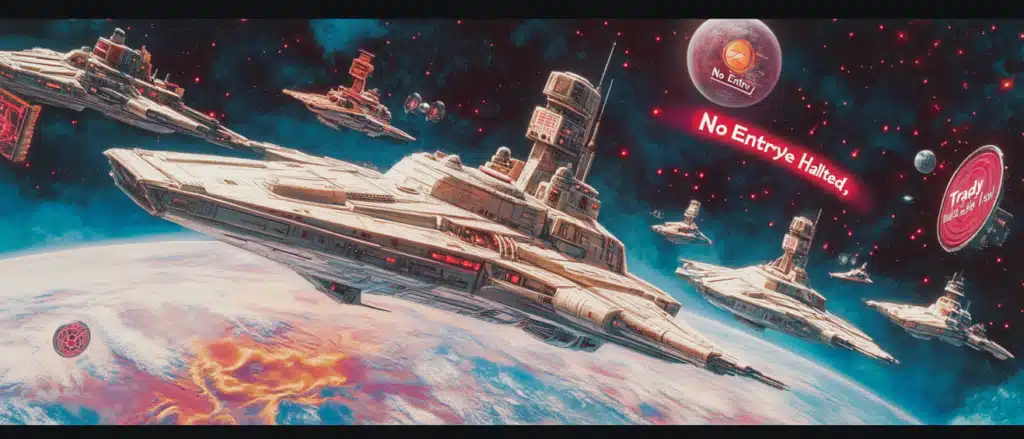
Galactic Blockades: The Space Equivalent of Throwing a Tantrum
In the grand saga of Star Wars, few things demonstrate just how quickly diplomacy can fall apart like a good old-fashioned blockade. Whether it’s a show of economic might, a desperate cry for attention, or a devious political maneuver, blockades in the galaxy far, far away often serve as the spark for much larger conflicts. In this chapter, we’ll dive deep into how these space-based tantrums reflect power struggles, economic pressure, and political agendas—all with the classic Star Wars flair.
The Naboo Blockade: The Case Study That Started It All
Let’s kick things off with the blockade that got everyone’s attention in Episode I: The Phantom Menace. When the Trade Federation encircled the planet of Naboo with a fleet of battleships, it wasn’t just an arbitrary decision. This was the galaxy’s equivalent of throwing a tantrum and slamming the proverbial door shut—only instead of grounding someone, it involved massive starships, battle droids, and political brinkmanship.
The Trade Federation was fuming over new taxes on trade routes imposed by the Galactic Senate, and they weren’t about to take it lying down. In their minds, the best way to show their displeasure wasn’t through a strongly worded holo-message or a few sternly written datapads—it was by blockading an entire planet and choking off its supply lines. The resulting chaos highlighted just how devastating a blockade could be, cutting off essential goods, food supplies, and access to other star systems. Naboo’s isolation became a symbol of how quickly economic pressure could escalate into a humanitarian and political crisis.
Why Blockade When You Can Negotiate? Because it’s the Star Wars Way
You might wonder: why did the Trade Federation resort to such drastic measures? Couldn’t they have sent an angry delegation or tried to negotiate a new deal? Sure, but in the Star Wars universe, subtlety is about as rare as a Force-sensitive Ewok. Blockades are a demonstration of raw power—a way to flex economic and military muscle while simultaneously creating a spectacle. They force other factions to sit up and take notice, creating urgency, tension, and political pressure.
Blockades aren’t just about cutting off trade; they’re about sending a message. When the Trade Federation surrounded Naboo, they weren’t simply targeting Queen Amidala and her people—they were making a point to the entire galaxy. Their message was clear: mess with our profits, and we’ll mess with your entire planetary system. While the methods were undoubtedly harsh (and more than a little over-the-top), the move demonstrated the lengths to which economic powers would go to defend their interests.
The Political Chessboard: Using Blockades to Leverage Power
In Star Wars, blockades are more than acts of petulance; they are deliberate political maneuvers. By initiating a blockade, a faction can force concessions, alter political alliances, and even provoke wars. The Separatist Alliance, for example, used blockades throughout the Clone Wars to destabilize systems loyal to the Republic. By cutting off essential trade, they weakened planets economically and politically, making it easier to recruit them to their cause or pressure them into submission.
A prime example of this strategy can be found in the blockade of Christophsis. During the Clone Wars, the Separatists surrounded this strategically important planet with their fleet, effectively cutting off all aid and trade. Their goal was simple: isolate the planet, weaken its defenses, and force it to capitulate to Separatist demands. The Republic, however, wasn’t about to let this happen. The ensuing battle for Christophsis became one of the early defining moments of the Clone Wars, illustrating how blockades could quickly escalate into full-blown conflicts.
Blockades aren’t always about immediate gains. Often, they’re about the long game—forcing a planet, faction, or even the entire Republic to bend to the will of those imposing the blockade. In this sense, they function as both a military tactic and a form of economic warfare.
Blockades and the Empire: A Tool of Oppression
Under the rule of the Galactic Empire, blockades became a favored tool of oppression and control. Palpatine and his Imperial forces understood the psychological and economic power of blockades. By surrounding rebellious planets and cutting off their access to supplies, they could swiftly crush dissent and bring unruly systems to heel. In many cases, the mere threat of a blockade was enough to force planetary governors and local leaders to capitulate to the Empire’s demands.
The Empire’s blockade of Lothal during the events of Star Wars Rebels is a chilling example of this tactic in action. Faced with growing resistance from the Rebel Alliance, the Empire surrounded Lothal, cutting off its trade and enforcing martial law. The blockade served as a way to suppress dissent, isolate the local population, and exert total control over the planet’s resources and industry. For the people of Lothal, the blockade wasn’t just a military strategy—it was a living nightmare, a daily reminder of Imperial dominance.
Economic Warfare 101: The Devastating Impact of Blockades
It’s easy to overlook just how devastating blockades can be. In a galaxy that thrives on trade and interplanetary commerce, cutting off a planet’s supply lines can lead to food shortages, economic collapse, and humanitarian crises. Blockades disrupt trade routes, prevent the flow of goods, and isolate entire populations, turning vibrant planets into desolate wastelands. They are the ultimate form of economic warfare—an attack not just on a planet’s defenses but on its very livelihood.
Beyond the immediate economic impact, blockades often serve as catalysts for political unrest and rebellion. People faced with starvation, deprivation, and economic ruin are far more likely to rise up against their oppressors. This is precisely why blockades are such powerful tools for both intimidation and resistance. They force people to make impossible choices, leading to alliances, revolts, and sometimes even full-scale wars.
Blockades in Real-World Context: Space Tantrums and Historical Parallels
Blockades may seem like a uniquely Star Wars phenomenon, but they have strong parallels in real-world history. Throughout human history, blockades have been used as tools of war and economic pressure. The British blockade of Napoleonic France, the Union blockade of Confederate ports during the American Civil War, and more modern economic sanctions all mirror the tactics seen in Star Wars. These real-world examples highlight how cutting off trade and resources can lead to desperation, conflict, and political change.
In the Star Wars universe, the stakes are often much higher (after all, we’re talking about entire planets, not just ports), but the underlying principles remain the same. Blockades are about power—who has it, who can wield it, and who can endure it.
Rebel Blockades: Turning the Tables
While blockades are often associated with the Empire, the Rebel Alliance wasn’t above using similar tactics when necessary. Faced with limited resources and overwhelming odds, the Rebels sometimes employed their own form of economic pressure, targeting Imperial supply lines and disrupting trade routes critical to the Empire’s war machine. By striking at the heart of Imperial logistics, they weakened their enemy and kept their cause alive.
Rebel blockades, however, often came with moral complications. Unlike the Empire, which wielded blockades as tools of oppression, the Rebels had to balance their tactics with the principles they fought for. Cutting off supplies to Imperial loyalists might have been necessary for victory, but it could also lead to suffering among innocent civilians. This moral gray area underscores the complexity of using economic warfare as a means of achieving political ends.
Blockades in the Criminal Underworld: Smugglers, Syndicates, and Space Pirates
Blockades aren’t just for governments and galactic factions. In the underbelly of the galaxy, smugglers, crime syndicates, and space pirates frequently used blockades (or, more often, circumvented them) as part of their operations. The Hutt Cartel, for instance, leveraged its control over certain hyperlanes to impose their own version of trade restrictions—often with a heavy dose of extortion and illegal trafficking.
Smugglers like Han Solo made their fortunes by running blockades, slipping through Imperial nets, and delivering much-needed supplies to desperate systems. In many cases, they were the lifeline for planets facing economic strangulation. Blockades created opportunities for daring raids, high-stakes missions, and the occasional high-speed chase through asteroid fields. For the galaxy’s outlaws, blockades weren’t just obstacles—they were invitations for adventure and profit.
In the Star Wars galaxy, blockades are far more than temper tantrums in space. They’re a strategic tool wielded by factions vying for power, a method of economic coercion, and a catalyst for political upheaval. Whether imposed by the Trade Federation, the Separatists, the Empire, or the Rebels, blockades reflect the complex interplay of commerce, politics, and warfare that defines the galaxy far, far away. They remind us that in a universe where every credit counts, the power to stop the flow of goods can be just as potent as the power to wield a lightsaber.
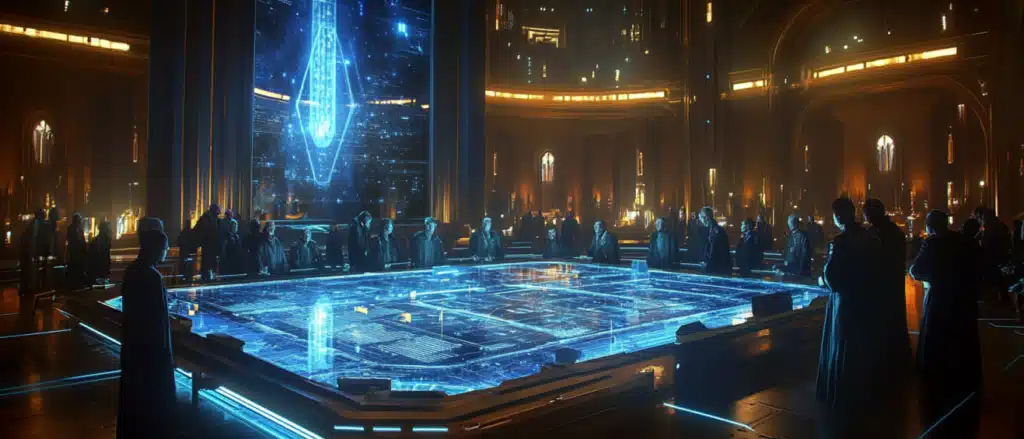
Trade and Taxes: Why They Matter in Galactic Policy
When you think of Star Wars, it’s easy for your mind to wander to epic lightsaber duels, space battles, and the struggle between the light and dark sides of the Force. What probably doesn’t immediately leap to mind is the thrilling subject of taxes. But peel back the layers of political intrigue, and you’ll find that trade and taxation are critical to understanding why the galaxy is constantly in a state of turmoil. In Star Wars, these aren’t just dry fiscal matters—they’re at the heart of galactic conflict, power struggles, and even the rise of the Empire itself.
Taxes: The Catalyst for Galactic Chaos
Taxes were the spark that set off the events of The Phantom Menace. The Galactic Republic, eager to increase its revenue and regulate the flow of goods, imposed taxes on trade routes in the outer rim territories. These taxes weren’t just an accounting exercise; they represented a fundamental shift in how commerce was conducted across the galaxy. For centuries, free trade zones had allowed organizations like the Trade Federation to operate with minimal oversight, raking in massive profits. Suddenly, with the new tax laws, their wallets were under siege.
The Trade Federation, led by Viceroy Nute Gunray, wasn’t about to let this slide without a fight—or at least without some significant leverage. In response to the tax regulations, they imposed a blockade on Naboo, using economic pressure as their primary weapon. It’s a classic example of taxation leading directly to economic conflict, showing just how deeply these policies can influence galactic events.
Taxes might seem mundane, but in the context of Star Wars, they have the power to topple governments, spark wars, and destabilize entire regions. When you look at it from that perspective, taxes suddenly seem a lot more interesting (or at least a lot more dangerous).
The Galactic Senate: A Bureaucratic Nightmare
If there’s one thing the Galactic Senate loved, it was endless debates—and nothing fueled those debates more than taxes and trade regulations. Imagine thousands of senators from countless star systems, each with their own agendas, all trying to impose or resist new tax laws. Now throw in corporate interests, special interest groups, and the occasional Sith Lord in disguise, and you’ve got yourself a recipe for gridlock.
The taxation of trade routes wasn’t just a financial issue; it was a deeply political one. Wealthy core planets often pushed for regulations that would benefit their economies, while outer rim systems, already struggling with limited resources and unstable economies, pushed back. This created a clear divide between the haves and have-nots of the galaxy, further fueling tensions and resentment.
The Senate’s inability to handle these issues efficiently became a major point of contention. For many systems, it was evidence that the Republic was no longer capable of representing their interests, making them ripe for secession and rebellion. And who was there to exploit this discontent? That’s right—our good friend Palpatine, who used every economic crisis to consolidate his power.
Trade Agreements: The Devil is in the Details
Trade agreements in Star Wars are anything but straightforward. Negotiating trade routes, tariffs, and tax exemptions requires more skill than dodging blaster bolts in a firefight. These agreements often dictated which planets could thrive economically and which would struggle to survive. Powerful organizations like the Trade Federation and the Banking Clan used their influence to carve out favorable trade deals that allowed them to amass wealth and power. Meanwhile, smaller systems were often left with little choice but to accept whatever terms were handed to them.
Trade agreements also became political tools used to curry favor or exact revenge. Want a planet’s support for a key Senate vote? Promise them reduced tariffs on their exports. Need to punish a rebellious system? Impose crushing taxes on their goods. In this way, trade policies became instruments of political control, wielded by both the Republic and later the Empire to maintain power and shape galactic alliances.
Taxation and the Rise of the Empire
Palpatine’s ascension to power wasn’t solely due to his mastery of the dark side; he was also a master manipulator of economic policy. Under his rule as Emperor, taxes and trade regulations took on a more sinister purpose. While the Republic had used taxes to generate revenue and (ostensibly) promote stability, the Empire used them to enforce loyalty and crush dissent.
Planets loyal to the Empire enjoyed favorable tax treatment, allowing them to prosper under Imperial rule. Those that resisted faced crushing taxes, economic blockades, and trade restrictions designed to bring them to their knees. This economic pressure forced many planets to comply with the Empire’s demands, whether through fear of financial ruin or simply a lack of alternatives.
The Empire also nationalized many of the galaxy’s trade routes and resources, placing them under Imperial control. This effectively eliminated any possibility of economic independence for most planets, consolidating power within the Imperial hierarchy. While the Death Star was a powerful symbol of military might, it was economic domination that truly kept systems in line.
The Role of Trade in Rebellion and Resistance
While the Empire used taxes and trade to maintain control, the Rebellion used them to fight back. Rebel forces relied on smugglers, underground markets, and covert trade routes to supply their troops and fund their operations. Taxation and trade regulations imposed by the Empire created a thriving black market, as desperate citizens turned to illegal means to acquire goods and evade Imperial oversight.
Smugglers like Han Solo and organizations like the Rebel Alliance understood the importance of controlling trade routes and bypassing Imperial taxes. Every shipment of weapons, food, and supplies that made it past Imperial patrols represented another small victory for the Rebellion. Trade wasn’t just an economic issue—it was a lifeline for the fight against tyranny.
Taxation and Trade in the New Republic
After the fall of the Empire, the New Republic faced the daunting task of rebuilding a galaxy shattered by years of war and economic exploitation. Taxes and trade policies became a key focus of their efforts. How could they promote economic recovery while avoiding the pitfalls that had led to the Empire’s rise? How could they create fair trade agreements that balanced the interests of wealthy core planets and struggling outer rim worlds?
The New Republic’s leaders had to navigate a complex web of competing interests, corporate influences, and war-torn economies. Failure to do so risked repeating the mistakes of the past, creating new opportunities for chaos and authoritarian rule. It’s a reminder that even in a galaxy liberated from the dark side, the challenges of trade and taxation never truly go away.
Economic Inequality and Taxation: A Galactic Balancing Act
One of the central challenges of taxation in Star Wars is the issue of economic inequality. Planets in the core of the galaxy often enjoyed immense wealth and prosperity, while those on the fringes struggled to make ends meet. Tax policies and trade regulations often exacerbated this divide, leading to resentment and unrest.
For many outer rim worlds, high taxes and restrictive trade policies imposed by the Republic or the Empire made it nearly impossible to compete economically. They were often left to fend for themselves, leading to crime, poverty, and instability. The Hutts, crime syndicates, and other unsavory characters were quick to fill the power vacuum, offering their own brand of “trade agreements” that usually involved illegal trafficking, slavery, and extortion.
Economic inequality and taxation weren’t just abstract issues—they were tangible problems that shaped the lives of billions. Whether it was the exploitation of Ryloth’s resources, the domination of spice trade by criminal cartels, or the poverty faced by backwater worlds, trade and taxes were at the heart of it all.
The Bureaucracy of Taxation: A Comedy of Errors
It would be remiss not to mention the often absurd nature of taxation and trade regulation in the Star Wars galaxy. The Republic’s bureaucracy was legendary for its inefficiency, with endless committees, subcommittees, and regulatory bodies debating every detail. In the middle of it all were hapless senators, beleaguered diplomats, and droid accountants trying to make sense of a galaxy’s worth of tax codes.
The bureaucratic mess often created opportunities for corruption and manipulation. Corporate interests would grease the wheels, while corrupt officials looked the other way. Meanwhile, honest citizens and small-time traders were left to navigate a labyrinth of tax laws that seemed designed to frustrate more than regulate. It’s no wonder that many systems turned to more “creative” ways of bypassing taxes and tariffs.
In the Star Wars galaxy, trade and taxes are far more than dry fiscal policies—they’re a reflection of power, control, and the constant struggle for dominance. From the Trade Federation’s blockade of Naboo to the Empire’s oppressive tax policies, economic regulation shapes the fate of planets and defines the course of history. Taxes and trade might not come with the flash of a lightsaber duel, but they’re every bit as important in determining who wins, who loses, and who rises to power in a galaxy far, far away.
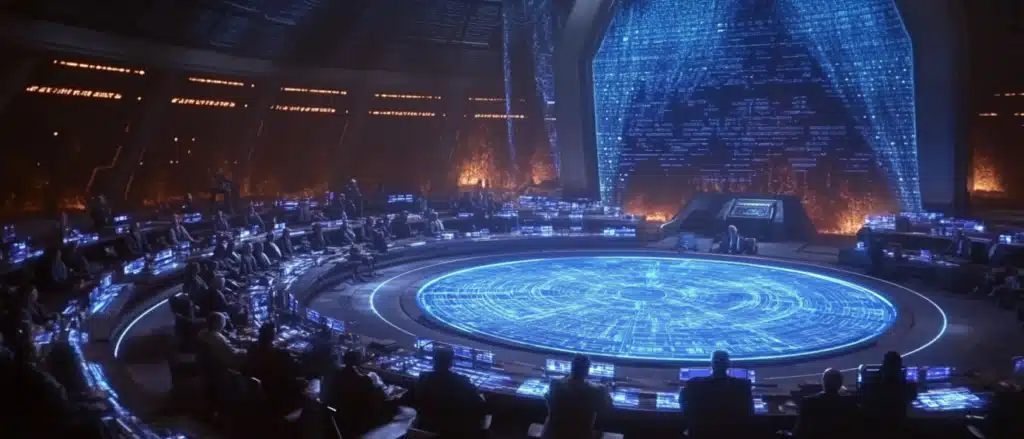
Economic Strife and Rebellion: When Credits Push Planets to War
The Star Wars galaxy is no stranger to conflict, but behind the blasters, lightsabers, and grand political movements lies an often-overlooked root cause: economic strife. While it’s easy to get swept up in the romance of Rebellion versus Empire or Jedi versus Sith, the gritty truth is that many of these conflicts were born out of economic hardship, resource scarcity, and economic oppression. In a galaxy driven by commerce, trade, and the flow of credits, economic issues often serve as the true spark that pushes planets and people to war. Let’s dive into how economic strife fuels rebellion, and why the battle for economic justice is as crucial as any struggle against a Sith Lord.
The Core Versus the Outer Rim: A Tale of Economic Inequality
To understand the galaxy’s economic struggles, it’s important to first recognize the deep economic divide between the wealthy Core Worlds and the struggling Outer Rim territories. The Core, home to planets like Coruscant and Alderaan, enjoyed vast wealth, thriving commerce, and strong representation in the Galactic Senate. Meanwhile, Outer Rim planets often found themselves marginalized, neglected, and economically disadvantaged. This inequality created a simmering resentment that would eventually erupt into open conflict.
Outer Rim planets, rich in resources but lacking economic power, were frequently exploited by corporations and the Republic itself. Mining operations, resource extraction, and forced labor became common, with profits flowing to the Core while Outer Rim populations were left to suffer. This economic disparity created fertile ground for dissent and rebellion, as disenfranchised populations sought a better future beyond the grip of oppressive policies and indifferent bureaucrats.
The Catalyst for Rebellion: Economic Oppression by the Empire
When Palpatine transformed the Republic into the Galactic Empire, he tightened his grip on the galaxy through economic means as much as military force. The Empire’s economic policies were designed to consolidate power, crush dissent, and maintain total control. Planets that supported the Empire were rewarded with economic incentives, lucrative contracts, and favorable trade terms. Those that resisted faced harsh taxes, resource confiscation, and economic sanctions that left them impoverished.
Consider Lothal, a planet that exemplifies the Empire’s ruthless economic control. Once a thriving agricultural world, Lothal’s economy was hijacked by the Empire to fuel its war machine. The Empire exploited Lothal’s resources, turning once-productive farmlands into factories and mining operations. The local population suffered under oppressive labor conditions, while any attempts at resistance were met with harsh reprisals. For the people of Lothal, rebellion wasn’t just a political choice—it was a matter of survival.
This pattern repeated itself across countless planets. The Empire’s economic stranglehold created widespread suffering, leaving entire systems with no option but to fight back. Rebellion became a necessity, driven not just by a desire for political freedom, but by the need to escape economic subjugation.
The Role of Trade Sanctions and Embargoes
In the galaxy of Star Wars, trade sanctions and embargoes are frequently used as tools of control and coercion. When a planet or faction defies the dominant political power—be it the Republic, the Empire, or the Separatists—it often finds itself cut off from vital resources and trade networks. This economic isolation can be just as devastating as a full-scale military assault.
A prime example of this can be seen during the Clone Wars, when the Separatist Alliance used economic blockades and embargoes to force planets into compliance. By disrupting trade routes and preventing access to essential goods, they weakened their enemies and forced systems to either submit or suffer the consequences. The Republic, for its part, employed similar tactics to undermine Separatist-held worlds, creating a cycle of economic warfare that fueled the larger conflict.
For many planets, economic sanctions left them with no choice but to rebel. When faced with starvation, resource shortages, and economic ruin, rebellion became a means of survival—a desperate attempt to break free from economic oppression and restore stability.
Rebellion Funded by Smugglers and Crime Syndicates
While the Empire wielded economic power to maintain control, the Rebel Alliance had to get creative in order to fund its operations. Unlike the Empire, which had access to vast resources and a centralized economic structure, the Rebellion was a grassroots movement dependent on secretive trade, smuggling, and alliances with less-than-savory groups. In a galaxy where credits can mean the difference between survival and defeat, the Rebellion often found itself forging alliances with smugglers, pirates, and crime syndicates willing to support the cause.
Characters like Han Solo and organizations like the Hutt Cartel played key roles in funding and supplying the Rebellion. Smuggling operations became essential for moving weapons, food, medical supplies, and other resources past Imperial patrols. In many ways, the economic struggles of the Rebellion mirrored those of real-world insurgencies, relying on clandestine networks and underground markets to survive.
Of course, these alliances weren’t without complications. Dealing with criminals and smugglers often forced the Rebellion to walk a fine line between morality and necessity. While the Empire may have represented overt oppression, the Rebellion’s economic struggles highlighted the complexities of fighting a war with limited resources and unorthodox allies.
The Underbelly of Economic Strife: Crime Syndicates Thrive
Economic strife doesn’t just drive rebellion—it also creates opportunities for criminal enterprises to flourish. In the Star Wars galaxy, the Hutts, Black Sun, and countless other crime syndicates took full advantage of economic instability, positioning themselves as alternative sources of trade and power. When official channels failed or became corrupt, people turned to the underworld for smuggling, illegal trade, and protection.
For many Outer Rim planets, dealing with crime syndicates became a necessary evil. When legitimate trade routes were blocked or taxed into oblivion, smuggling became the only way to access essential goods. This gave crime lords immense economic and political power, allowing them to manipulate local populations, exploit workers, and carve out fiefdoms that operated outside the Republic’s or Empire’s control.
The connection between economic strife and crime highlights one of the galaxy’s darkest realities: desperation often drives people into the arms of dangerous allies. While crime syndicates profited from economic chaos, they also played a role in undermining Imperial control, creating a complex web of alliances and rivalries that further fueled conflict.
Economic Strife as a Catalyst for Unity and Division
Economic hardship has a paradoxical effect: it can unite people in common cause or deepen divisions and mistrust. The Rebel Alliance, for instance, was born out of the collective desire of disparate planets and factions to resist the Empire’s economic oppression. By banding together, they pooled their limited resources, shared intelligence, and fought for a common goal. Economic struggle became a unifying force, strengthening the resolve of the Rebellion and giving hope to those who had none.
However, economic strife also created divisions within the Rebellion itself. Different factions had different priorities, resources were scarce, and tensions often flared over how best to allocate them. The political and economic complexities of uniting so many diverse groups often tested the Rebellion’s ability to remain cohesive. Disagreements over trade agreements, resource distribution, and economic strategy sometimes threatened to tear the movement apart.
Economic Strife in Star Wars Legends and Expanded Universe
The impact of economic hardship extends far beyond the movies, playing a significant role in the Star Wars Expanded Universe (now known as Legends). Novels, comics, and games often explore the gritty details of economic struggle, from the rise of pirate empires to corporate wars that destabilize entire systems.
In Timothy Zahn’s Thrawn Trilogy, for example, economic strife becomes a key factor as the remnants of the Empire seek to reclaim lost territories and resources. Characters like Talon Karrde, a smuggler and information broker, navigate the complex web of trade, politics, and conflict to maintain their own interests while playing both sides of the war. The Expanded Universe shows just how deeply economic issues can influence characters’ motivations, drive political intrigue, and shape the galaxy’s fate.
Resource Wars: Fighting Over Scarcity
Economic strife in Star Wars often centers on resource scarcity. Planets rich in natural resources, such as spice mines, rare minerals, or agricultural bounty, become targets for exploitation and conflict. Mining operations on planets like Kessel, for instance, reveal how desperate factions will fight for control over valuable resources. The brutal conditions of the spice mines, combined with high demand and harsh Imperial regulation, create a microcosm of economic exploitation and rebellion.
Resource wars highlight the lengths to which factions will go to secure their economic future. Planets and factions willing to fight to the death over scarce resources underscore the idea that economic survival often means fighting for every last credit, shipment, or mining claim.
Economic Strife Beyond the Empire: Post-Empire Struggles
Even after the fall of the Empire, economic strife continued to plague the galaxy. The New Republic faced immense challenges in rebuilding shattered economies, addressing inequality, and creating a stable economic foundation. Former Imperial worlds struggled to adapt to new trade policies, while war-torn planets grappled with rebuilding infrastructure and stabilizing their economies. Economic rebuilding became just as important as political stability, proving that credits can shape the fate of a galaxy long after the blaster fire has stopped.
In Star Wars, economic strife is a powerful force that shapes rebellions, drives characters, and determines the course of galactic history. Whether through oppression, desperation, or opportunity, economic struggles touch every corner of the galaxy. They remind us that even in a world of Jedi and Sith, the power of credits—and the human (or alien) cost of economic hardship—can mean the difference between freedom and tyranny, hope and despair.
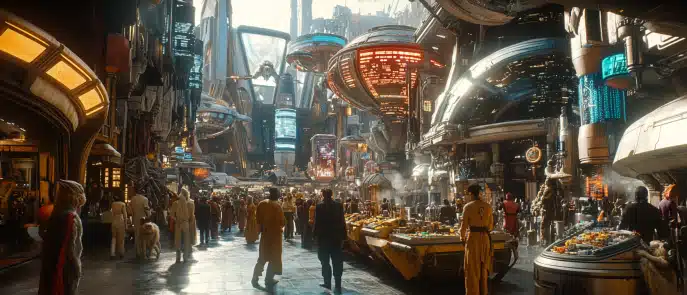
Games, Books, and Comics: Expanding the Trade Lore
The films may form the backbone of the Star Wars saga, but the galaxy far, far away truly comes alive through its expansive universe of games, books, and comics. While most people come for the lightsaber duels and starship battles, these expanded media have often taken the time to explore the complexities of trade, commerce, and economic power in the galaxy. From galactic trade routes to corporate intrigue, these stories delve deeper into how trade shapes politics, fuels conflict, and influences the daily lives of characters beyond the big screen.
Video Games: The Economic Playground of the Galaxy
Star Wars video games often allow players to immerse themselves in the economic side of the galaxy in ways that movies can’t. Whether through grand strategy, resource management, or smuggling missions, players get a firsthand look at how trade and economic policies shape the galaxy’s fate.
- “Star Wars: The Old Republic” (SWTOR)
- As a massively multiplayer online role-playing game (MMORPG), SWTOR lets players experience life in the Star Wars galaxy during the height of the Sith Empire’s power. The game features extensive storylines that delve into trade disputes, corporate corruption, and smuggling rings. Players can align with different factions, make deals, and even manipulate trade routes to gain influence.
- One notable story arc involves a corporation exploiting a resource-rich planet, leading to an uprising. Players must navigate the complex political and economic dynamics, deciding whether to support the corporation’s interests, help the oppressed, or find a way to profit from the chaos.
- “Star Wars: Rebellion”
- This strategy game puts players in command of either the Galactic Empire or the Rebel Alliance, with a significant focus on resource management, production, and trade control. Controlling planets isn’t just about military might; it’s about securing economic resources and maintaining trade routes.
- Players must decide how to allocate limited resources, recruit characters to sabotage enemy trade operations, and manage diplomatic relations to secure vital economic support. Rebellion demonstrates how trade and economics can be as critical to victory as battlefield tactics.
- “Star Wars: Empire at War”
- In this real-time strategy game, players can engage in galactic-scale warfare while also managing economic resources. Controlling key trade routes and planets is crucial to building a war machine capable of defeating the opposing faction.
- The game highlights the importance of economic strategy, showing how controlling trade routes and managing resources can lead to victory or defeat. Players must balance the need for economic expansion with the risks of overextending their control.
- “Star Wars Jedi: Fallen Order” and the Role of the Scrapper Guild
- While Fallen Order is primarily an action-adventure game focused on Jedi Cal Kestis, it still touches on economic themes. The game begins on Bracca, a planet dedicated to scrapping old Republic and Separatist ships. The Scrapper Guild, a corporation that exploits laborers to dismantle starships, is emblematic of how corporate power dominates entire planets and their economies in the Star Wars universe.
Books: Economic Intrigue and Galactic Politics
The Star Wars books have long been a treasure trove of stories that explore economic themes and trade lore. From high-stakes corporate intrigue to tales of economic desperation, the novels offer a deeper look at how credits and trade shape the galaxy’s destiny.
- “Thrawn Trilogy” by Timothy Zahn ( get it here )
- This beloved series delves into the machinations of Grand Admiral Thrawn as he attempts to rebuild the Empire’s strength after the fall of Palpatine. Economic power plays a critical role, as Thrawn uses resource manipulation, secret factories, and trade deals to rally Imperial remnants.
- One subplot involves Talon Karrde, a smuggler and information broker, who uses his economic influence and trade network to gain leverage over various factions. The books showcase the importance of economic power in determining political outcomes.
- “Catalyst: A Rogue One Novel” by James Luceno ( Get it here )
- This prequel to Rogue One explores the rise of the Death Star project and the economic pressures that drive it. Galen Erso, a scientist, is manipulated into working on the superweapon under the guise of an energy initiative. The novel highlights the economic exploitation and resource gathering that went into building the Empire’s ultimate weapon.
- The book also delves into how corporations and powerful industrialists, like Orson Krennic, used economic incentives and coercion to gain loyalty and power. It’s a stark reminder of how trade and resources can be twisted for political ends.
- “Queen’s Shadow” by E.K. Johnston ( Get it here )
- This novel follows Padmé Amidala as she transitions from Queen of Naboo to a senator in the Galactic Senate. One of the main storylines involves Padmé navigating trade disputes and economic policies that affect her home planet. The book offers a rare glimpse into the complex world of galactic politics, where trade negotiations can determine a planet’s prosperity or decline.
- “Aftermath Trilogy” by Chuck Wendig ( Get it here )
- Set after the fall of the Empire, these novels explore the power vacuum that emerges in the galaxy. Economic instability, warlordism, and trade disputes plague the New Republic as it struggles to bring order to a shattered galaxy.
- The trilogy highlights how economic chaos can lead to political instability, with factions vying for control of trade routes, resources, and planets. The struggle to rebuild trade networks and restore economic stability becomes a key part of the New Republic’s challenges.
Comics: Corporate Intrigue and Economic Exploitation
The Star Wars comics have never shied away from exploring the darker side of trade and commerce in the galaxy. With visually compelling storytelling, they bring to life stories of corporate greed, smuggling operations, and economic battles that shape the galaxy.
- “Darth Vader: Dark Lord of the Sith” Series
- This comic series follows Vader’s rise within the Empire and his efforts to consolidate power. One storyline focuses on the Empire’s efforts to nationalize key industries and bring corporate sectors under Imperial control. Vader’s ruthless approach to dealing with uncooperative corporate leaders demonstrates the Empire’s iron grip on trade and commerce.
- “Doctor Aphra” Series
- Doctor Aphra, a rogue archaeologist with a penchant for getting into trouble, often finds herself entangled in economic schemes, smuggling operations, and corporate intrigue. The series explores the shady side of galactic trade, with Aphra dealing with crime syndicates, Hutt lords, and corrupt corporate executives.
- Her adventures highlight the precarious balance between profit and survival in the Star Wars underworld. Whether it’s trading ancient artifacts, brokering dangerous deals, or outwitting rival smugglers, Aphra’s escapades reveal just how chaotic and dangerous the galaxy’s trade networks can be.
- “Star Wars: Poe Dameron” Series
- This series dives into the Resistance’s struggle against the First Order, with an emphasis on resource management and supply chains. The Resistance, constantly outgunned and outnumbered, must rely on smuggling, secret trade deals, and underground support networks to stay in the fight.
- The comics illustrate the importance of economic support in sustaining a rebellion. Without access to resources and trade routes, even the most determined resistance movement can falter.
Smuggling, Piracy, and the Economics of the Underworld
The expanded universe often delves into the criminal side of trade, exploring how smugglers, pirates, and crime syndicates shape the galaxy’s economy. Characters like Han Solo, Lando Calrissian, and Hondo Ohnaka operate in a world where trade is both opportunity and danger.
- Hondo Ohnaka and the Pirate Syndicates
- Hondo Ohnaka, the charmingly unscrupulous pirate, represents the chaotic side of galactic trade. Through his various appearances in The Clone Wars and Rebels, Hondo navigates the complexities of smuggling, piracy, and black market trade. He often strikes deals with the highest bidder, blurring the line between heroism and self-interest.
- His storylines showcase how piracy and smuggling thrive in times of economic chaos and war, with pirates exploiting weakened trade routes, desperate factions, and isolated planets.
- “Star Wars: Scoundrels” by Timothy Zahn
- This novel follows Han Solo, Lando Calrissian, and a ragtag crew of smugglers as they attempt to pull off a heist against a crime lord. The book delves into the economics of the criminal underworld, exploring how crime syndicates control trade, manipulate markets, and amass power.
- The story highlights the blurred lines between crime and commerce, showing how smugglers and scoundrels navigate a galaxy where trade can be both lucrative and lethal.
Trade Guilds and Corporate Alliances: The Power Players
Many expanded universe stories explore the role of trade guilds and corporate alliances in shaping galactic politics. These organizations, including the Trade Federation, Techno Union, and Banking Clan, wield immense power through their economic influence.
- “Star Wars: The Clone Wars” Animated Series
- The series offers a deeper look into the motivations and actions of the galaxy’s largest corporate entities. Characters like Wat Tambor of the Techno Union and San Hill of the Banking Clan use their economic influence to manipulate the Clone Wars for profit and power.
- Episodes often focus on trade disputes, corporate espionage, and economic exploitation, showcasing how these organizations operate as political and economic powerhouses.
The Star Wars expanded universe of games, books, and comics paints a complex picture of trade, commerce, and economic influence. Whether through corporate intrigue, smuggling operations, or high-stakes trade negotiations, these stories reveal that the struggle for economic power is just as important—and just as dangerous—as any lightsaber duel. They remind us that in a galaxy defined by war and rebellion, the true battle for control often begins with the flow of credits and the manipulation of trade routes.
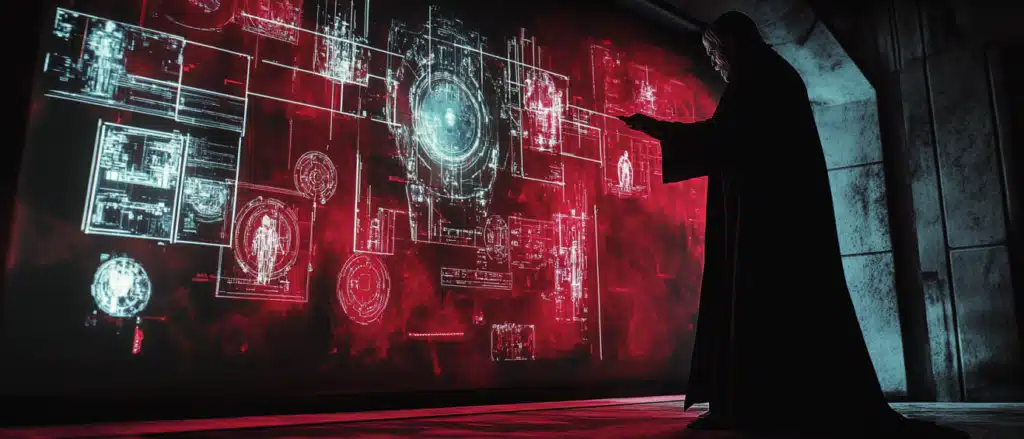
Conclusion: The Economics of Galactic Drama
In a galaxy defined by the clash of lightsabers, sprawling space battles, and the eternal struggle between light and dark, it’s easy to overlook the crucial role that economics and trade play in shaping the Star Wars universe. But dig beneath the surface, and you’ll find that credits, trade routes, taxes, and economic strife are the very threads that weave the galaxy’s most defining stories. The economics of Star Wars are more than just background noise—they’re the catalysts that drive political intrigue, spark rebellions, and empower empires.
Trade and Taxes: The Building Blocks of Galactic Control
Throughout the saga, we see time and again how trade and taxation form the backbone of galactic politics. The taxation of trade routes, a seemingly mundane policy decision, set off the events of The Phantom Menace, leading to a crisis that would ultimately bring down the Republic and usher in the reign of the Empire. For the Trade Federation, taxes were more than just a nuisance—they were a threat to their bottom line and a call to action. Their decision to blockade Naboo wasn’t just an act of economic protest—it was a power play that revealed how economic interests can spark galaxy-wide conflict.
Taxes and trade aren’t just numbers on a galactic balance sheet—they are levers of power that can be manipulated, twisted, and weaponized. Whether it’s the Galactic Senate’s attempts to regulate commerce or the Empire’s oppressive tax policies used to crush dissent, economic policies shape the destinies of countless worlds. In Star Wars, those who control trade and taxation control the galaxy itself.
Economic Warfare: The Quiet Force Behind Every Battle
The use of economic power as a weapon is a recurring theme in Star Wars. Blockades, embargoes, and trade sanctions have all been used to bring planets to their knees. The Trade Federation’s blockade of Naboo and the Separatist Alliance’s economic tactics during the Clone Wars serve as stark reminders of how economic warfare can be just as devastating as military conflict. By cutting off vital trade routes and resources, factions in the galaxy can exert control, weaken enemies, and force entire planets into submission.
The Empire, under the rule of Palpatine, perfected the art of economic oppression. Loyal planets were rewarded with economic incentives, while rebellious worlds were economically strangled through crushing taxes and trade restrictions. For the people living under Imperial rule, economic survival often became a fight for freedom, leading many to join the Rebellion and resist the Empire’s tyranny. It’s a powerful reminder that economics isn’t just about wealth—it’s about power, control, and the ability to shape the galaxy’s fate.
Economic Desperation and Rebellion: The Drive for Change
For many, rebellion isn’t born out of political ideology alone—it’s born out of economic desperation. The Star Wars saga is full of examples where economic oppression pushed people to the brink and forced them to take up arms. Whether it’s the oppressed citizens of Lothal under the Empire’s boot or the countless Outer Rim planets exploited by corporate interests, economic hardship often serves as the spark that ignites rebellion.
The Rebel Alliance itself relied on economic support from smugglers, crime syndicates, and sympathetic planets willing to defy the Empire’s economic stranglehold. Without access to resources, trade routes, and financial backing, the Rebellion would have struggled to survive. The economics of rebellion are complex and morally fraught, highlighting the difficult choices faced by those who seek to overthrow tyranny. In the end, economic desperation isn’t just a background factor—it’s the beating heart of resistance in a galaxy that often feels as oppressive as it is expansive.
Corporate Interests and Political Corruption: A Galaxy Shaped by Greed
The Star Wars galaxy is rife with corporate interests seeking to maximize profits at the expense of others. The Trade Federation, Banking Clan, Techno Union, and countless other corporate entities wielded economic power to influence galactic politics, undermine the Senate, and even incite wars. Palpatine’s manipulation of these corporate interests was masterful—by playing on their greed and ambitions, he used them as pawns in his grand plan to seize control.
Corporate greed and political corruption aren’t just minor elements of Star Wars lore—they are central to the downfall of the Republic and the rise of the Empire. By exploring these themes, Star Wars offers a cautionary tale about the dangers of unchecked corporate influence and the moral corruption that can arise when economic power is allowed to dictate political decisions. It’s a reminder that the true battle for the galaxy isn’t fought solely with blasters and lightsabers—it’s fought in boardrooms, Senate chambers, and the dark corners where deals are struck.
Smugglers, Pirates, and the Shadow Economy
No discussion of Star Wars economics would be complete without mentioning the role of smugglers, pirates, and the criminal underworld. These characters and factions thrive in times of economic chaos, finding ways to exploit weaknesses in the system, bypass regulations, and make a profit in the most dangerous of situations. Smugglers like Han Solo, crime lords like Jabba the Hutt, and pirates like Hondo Ohnaka all operate within the galaxy’s shadow economy, serving as both allies and antagonists to larger factions.
For many in the galaxy, dealing with smugglers and pirates is a necessity born out of economic desperation. When legitimate trade routes are blocked, when taxes are too high to bear, or when resources are scarce, turning to the criminal underworld becomes the only way to survive. This gray area of Star Wars economics highlights the complex morality that defines the galaxy—sometimes, survival means making deals with the devil.
The Legacy of Economic Control: Beyond the Galactic Civil War
Even after the fall of the Empire, the struggle for economic control continued. The New Republic faced the daunting task of rebuilding a shattered galaxy, restoring trade routes, and addressing economic inequality that had festered for decades. Economic instability left many planets vulnerable to warlordism, crime syndicates, and power grabs by former Imperial loyalists. The economic scars of the Empire’s rule couldn’t be healed overnight, and the struggle to create a fair and stable economic system became a central challenge for the galaxy’s new leaders.
The sequel trilogy continues this exploration of economic themes, with the rise of the First Order fueled by corporate interests and secret resource stockpiles. The Resistance, once again, finds itself fighting against an oppressive regime with limited resources and a desperate need for economic support. The battle for economic control never truly ends—it evolves, taking on new forms as the galaxy’s power structures shift.
Economic Lessons from a Galaxy Far, Far Away
At its core, Star Wars reminds us that economic power is just as important as military might. Control over trade routes, taxation policies, and resource allocation can determine the fate of entire planets and shape the course of galactic history. The economic themes in Star Wars are a reflection of real-world struggles—highlighting the dangers of economic inequality, the corrupting influence of corporate power, and the resilience of those who fight for economic justice.
The next time you watch a Star Wars film or dive into the expanded universe, remember that the grand battles and political intrigue are underpinned by economic forces that make the galaxy tick. Trade disputes, taxes, and economic oppression may not have the same cinematic flair as a lightsaber duel, but they are the catalysts that drive the galaxy’s greatest stories. In the end, the economics of galactic drama are what make the Star Wars universe feel alive, complex, and deeply human—reminding us that even in a galaxy filled with starships and Sith Lords, the fight for economic freedom and justice is a battle worth waging.
So, may the credits flow freely, may your trade routes remain open, and may your negotiations never end in blaster fire—unless, of course, you’re in a galaxy where that’s the only way to get things done..
Stay up-to-date with the latest news, updates, and exclusive content! Click here to follow us on Google News and never miss a story from the galaxy and beyond.


